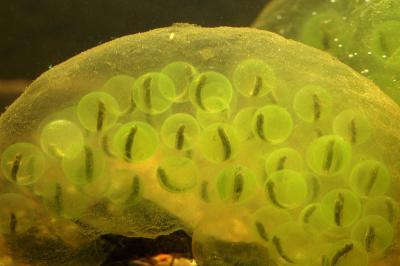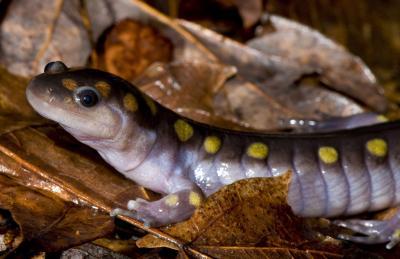BLOOMINGTON, Ind. -- A species of algae long known to associate with spotted salamanders has been discovered to live inside the cells of developing embryos, say scientists from the U.S. and Canada, who report their findings in this week's Proceedings of the National Academy of Sciences.
This is the first known example of a eukaryotic algae living stably inside the cells of any vertebrate.
"It raises the possibility that more animal/algae symbioses exist that we are not aware of," said Indiana University Bloomington biologist Roger Hangarter, the PNAS report's sole American coauthor. "Since other salamanders and some frog species have similar algae/egg symbioses, it is possible that some of those will also have the type of endosymbioses we have seen in the spotted salamander."
Biologists Ryan Kerney, Eunsoo Kim, Aaron Heiss, and Brian Hall of Dalhousie University in Halifax, Nova Scotia, and Cory Bishop of St. Frances Xavier University in Antigonish, Nova Scotia, are the other members of the research team. Kerney was the report's lead author.
"We were particularly excited to discover this association in spotted salamander embryos, because this species was a model organism for early experimental embryology research and is a locally common salamander in eastern North America," Kerney said. "We hope that this study will highlight biodiversity research on common North American species, which can easily be overlooked or even considered over-studied."
Vertebrates are backboned animals. The group includes amphibians like the spotted salamander, as well as mammals, birds and reptiles. The rarity of vertebrate endosymbiosis, as the cell-within-a-cell association is called, has been thought to be the result of the animals' stringently xenophobic immune systems. Any foreign cell that manages to get as far as breaching a cell membrane normally triggers a number of slay-now-and-ask-questions-later gene systems.
Naturalists first noticed an association between spotted salamander eggs and green algae more than 100 years ago. This relationship was formalized by name in 1927 by Lambert Printz, who named the algal species Oophilia amblystoma. The genus name means "egg loving." The nature of that symbiosis was not known until the 1980s, when experimentation revealed the salamander embryos do not develop as quickly or as fully in the absence of the green algae. Likewise, algae grown separately from the embryos but in the presence of water exposed to the embryos also grew more robustly.
Despite decades of study, the revelation of an endosymbiosis between the amphibian and alga took many by surprise when Kereny presented preliminary information at a scientific meeting last year. The reason, Hangarter said, is that the algae cells were not easy to see by conventional light microscopy. Because the chlorophyll in the algae is highly fluorescent, the scientists were able to use modern fluorescent microscopy to probe to the salamanders.
They also used a short string of nucleic acids that targets and binds to a ribosomal RNA molecule unique to Oophilia (18S rRNA) and by a visualization technique called fluorescence in situ hybridization, they found that the algae RNA is pervasive within spotted salamander embryo cells.

Salamander embryos grow inside egg capsules that are covered with and usually infiltrated by a type of green algae.
(Photo Credit: Courtesy of Roger Hangarter)
"With the ability to use gene-specific probes, it is now possible to determine the presence of organisms that may not be easily visible by standard light microscopy," Hangarter said. "In the past, researchers looking with simpler light microscopy techniques than are available today failed to see any algae in the salamanders."
The symbiotic relationship between spotted salamanders and Oophilia is mutualistic because both creatures benefit. Symbiosis is a general category of species-species interaction in which the organisms share space for extended periods of time. Symbioses can benefit one organism and harm the other (parasitism), benefit both (mutualism), or benefit one creature and leave the other unaffected (commensalism).
Endosymbiosis is a special type of symbiosis, requiring one organism to live inside the cells of another. It is not yet known how the endosymbiotic infiltration of salamander embryo cells affects either the salamander or the alga. Anything is possible, despite the fact that the overall relationship between the two species is established as mutualistically beneficial.
Endosymbiosis also has special evolutionary significance, as it is presumed by biologists to have preceded the full integration of certain cell organelles, such as mitochondria and chloroplasts, special structures that perform unique functions within cells -- and possess their own chromosomes.
Kerney and Hangarter say they hope their ongoing work will inspire interest in local biology and respect for environmental protection.
"We would like this work to draw attention to a fascinating yet common backyard salamander, and hope that it will both raise awareness of the species and promote the preservation of their fragile breeding habitat," Kerney said.
Hangarter agreed, adding, "I think it is important for people to realize that you do not need to go to exotic locations to make interesting scientific discoveries. The vernal ponds that the salamanders mate in are also essential for many other amphibians and other organisms, but such ponds are often among the first things destroyed when humans develop in wooded areas. One 500 square-foot pond might service several thousand mating salamanders and frogs that might inhabit an area of a few acres of woodland."

Spotted salamanders are the first known vertebrate to have an endosymbiont. The salamanders are found throughout eastern North America.
(Photo Credit: Courtesy of Roger Hangarter)
Source: Indiana University